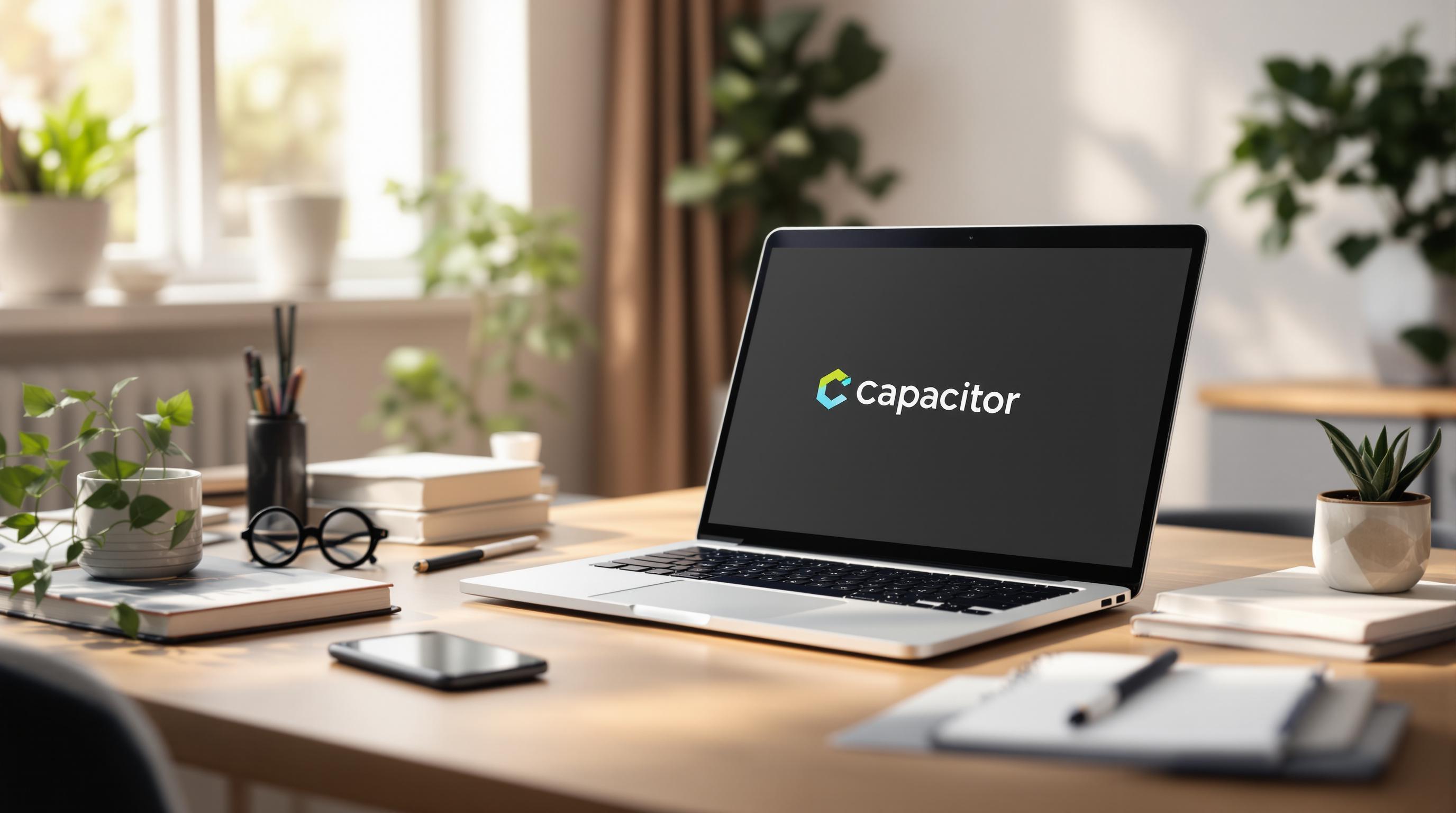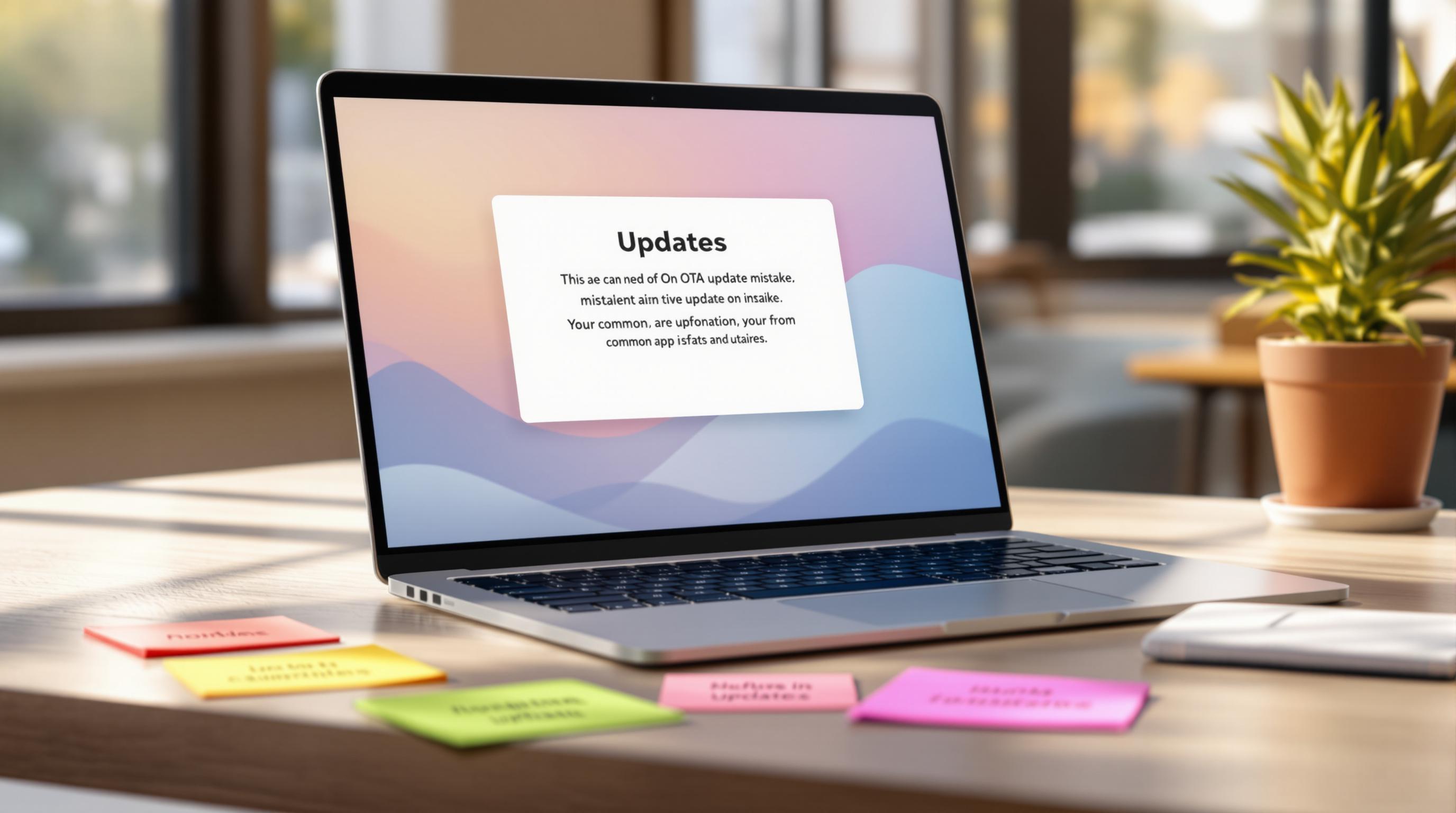Want to build mobile apps with a single codebase? Capacitor makes it easy to create iOS, Android, and web apps using frameworks like React, Angular, or Vue. This guide explains how to set up Capacitor, configure platforms, and deploy updates efficiently.
Key Steps to Get Started:
- Install Tools: Node.js, npm, Git, and a code editor like VS Code.
- Set Up Capacitor: Install the Capacitor CLI and initialize your project.
- Configure Platforms: Add iOS and Android support, adjust settings, and sync your code.
- Test and Deploy: Build, run on devices, and use live update tools like Capgo for seamless updates.
Capacitor bridges web apps with native device features, ensuring smooth performance across platforms. Follow this guide to simplify your app development process!
5 Steps to NATIVE APP with CAPACITOR | Ionic Release Guide

Required Tools and Setup
Here’s how to set up your development environment with the essential tools.
Development Tools Installation
To work with Capacitor, you’ll need the following tools:
| Tool | Purpose | Minimum Version |
|---|---|---|
| Node.js | JavaScript runtime environment | 14.0.0 or higher |
| npm | Package manager | 6.0.0 or higher |
| IDE/Code Editor | Development environment | Latest stable version |
| Git | Version control | 2.0.0 or higher |
Follow these steps to install them:
- Node.js and npm: Download and install both from the official Node.js website.
- Code Editor: Pick an editor like VS Code, WebStorm, or Sublime Text and install the latest stable version.
- Git: Get it from git-scm.com.
- Platform-specific tools: Install tools specific to your platform, like Xcode for macOS or Android Studio for Android development.
Once these are installed, you’re ready to move on to setting up the Capacitor CLI.
Capacitor CLI Setup
Get the Capacitor CLI up and running with these steps:
-
Install Capacitor CLI globally
Open your terminal and run the following command:
Terminal window npm install -g @capacitor/cli -
Initialize Capgo plugin
If you haven’t done this yet, run:
Terminal window npx @capgo/cli initThis will configure the necessary settings to manage updates effectively [1]. It simplifies the process for building, testing, and deploying your app.
Starting a New Capacitor Project
Once you’ve installed the necessary tools, you’re ready to set up your first Capacitor project. Here’s how to get started.
Creating Your Project
To create a new Capacitor project, open your terminal and use this command:
npx @capacitor/cli create [projectDirectory] [appId] [appDisplayName]For example:
npx @capacitor/cli create my-cap-app com.example.app "My Capacitor App"Here’s what each parameter means:
- projectDirectory: The name of your project folder (e.g.,
my-cap-app). - appId: A reverse-domain identifier for your app (e.g.,
com.example.app). - appDisplayName: The name displayed for your app (e.g.,
My Capacitor App).
After running this command, you’ll need to adjust your project settings in the capacitor.config.json file.
Configuring capacitor.config.json
The capacitor.config.json file is where you define the key settings for your project. Below is an example of a basic configuration:
{ "appId": "com.example.app", "appName": "My Capacitor App", "webDir": "dist", "bundledWebRuntime": false, "server": { "hostname": "app.example.com", "androidScheme": "https", "iosScheme": "https" }}Here’s a breakdown of the key options:
| Setting | Purpose | Example Value |
|---|---|---|
| appId | Unique identifier for your app | com.example.app |
| appName | The app’s display name | My Capacitor App |
| webDir | Directory for build output | dist |
| bundledWebRuntime | Whether to include Capacitor runtime | false |
| server.hostname | Hostname for the dev server | app.example.com |
| server.androidScheme | URL scheme for Android | https |
| server.iosScheme | URL scheme for iOS | https |
Installing Dependencies
To finalize the setup, install the required dependencies and initialize your project with these commands:
npm install @capacitor/corenpm install @capacitor/cli --save-devnpx cap initWith these steps completed, your project is ready for platform-specific setup and development.
Setting Up Mobile Platforms
Once your Capacitor project is initialized, the next step is to add and configure the iOS and Android platforms so your app can run natively on mobile devices.
iOS and Android Setup
Start by adding platform support using the following commands:
npx cap add iosnpx cap add androidAfter adding the platforms, sync your web code with:
npx cap syncBefore running these commands, make sure your web application is built and that the webDir in capacitor.config.json is correctly set. Once that’s done, customize each platform’s settings to align with your app’s needs.
Platform-Specific Settings
iOS
Open the iOS project with:
npx cap open iosThen, configure the following settings:
- Bundle Identifier: Ensure it matches your appId.
- Development Team: Assign the appropriate team for code signing.
- Deployment Target: Set the minimum iOS version.
- Device Orientation: Adjust as needed.
- Privacy Descriptions: Add required descriptions in
Info.plist.
Android
Open the Android project with:
npx cap open androidThen, update these settings:
- Package Name: Ensure it matches your appId.
- Permissions: Define necessary permissions in
AndroidManifest.xml. - Screen Orientation: Configure this in
AndroidManifest.xml. - Target SDK: Set the appropriate version in
android/app/build.gradle.
Asset and Configuration Locations
Here’s where you’ll find key files for app icons, splash screens, deep links, and permissions:
| Configuration | iOS Location | Android Location |
|---|---|---|
| App Icons | ios/App/App/Assets.xcassets | android/app/src/main/res |
| Splash Screens | ios/App/App/Assets.xcassets | android/app/src/main/res |
| Deep Links | ios/App/App/Info.plist | AndroidManifest.xml |
| Permissions | Info.plist | AndroidManifest.xml |
With these configurations in place, you’re ready to build and test your app on mobile devices.
Building and Testing
Using the setup outlined earlier, you can now build and test your Capacitor app to ensure it works correctly on various devices.
Build and Run Commands
Once your app is configured for mobile platforms, it’s time to build and run tests. Start by updating your web assets:
npm run buildnpx cap syncNext, use the appropriate commands for your target platform:
For iOS:
npx cap run iosFor Android:
npx cap run androidThese commands will build and launch your app on either a simulator or a connected device. Testing on both real devices and simulators is crucial to identify any platform-specific issues.
Adding Capacitor Plugins
Capacitor plugins allow you to add native features to your app. For example, to include camera, geolocation, and storage capabilities, run:
npm install @capacitor/camera @capacitor/geolocation @capacitor/storagenpx cap syncAfter installation, configure the plugins in your native projects. Here’s a quick overview of the setup requirements:
| Plugin | iOS Configuration | Android Configuration |
|---|---|---|
| Camera | Add Privacy Description | Add Permissions to Manifest |
| Geolocation | Add Location Usage Description | Add Location Permissions |
| Storage | No additional setup needed | No additional setup needed |
Live Updates with Capgo

To simplify deployment and testing, you can integrate live update tools like Capgo. This service has already delivered over 23.5 million updates, with 95% of users receiving updates within 24 hours and an 82% global success rate [1].
To add Capgo to your app:
npm install @capgo/capacitor-updaternpx cap syncCapgo offers several benefits during testing:
- Create separate channels for development, staging, and production environments.
- Push immediate bug fixes during testing.
- Track update success rates with built-in analytics.
- Roll back updates quickly if issues arise.
Capgo also ensures secure update delivery with end-to-end encryption. Its channel system allows you to test updates with select user groups before rolling them out to everyone.
Summary
This guide has walked through every phase of setting up and deploying a Capacitor app, covering all the essential steps needed to get started and ensure smooth operation.
Main Points
Creating a Capacitor app requires careful attention to setup, configuration, and platform-specific adjustments. Setting up your development environment - including tools like Node.js and the Capacitor CLI - is a crucial starting point. Configuring platforms like iOS and Android ensures the app works seamlessly on native systems.
Using an update system such as Capgo can simplify release management and help maintain app stability [1].
Here’s a breakdown of the key phases:
| Phase | Steps | Tips |
|---|---|---|
| Initial Setup | Install tools, CLI setup | Use the latest stable versions |
| Configuration | Adjust platform settings, add plugins | Follow platform-specific guidelines |
| Testing | Build and test on devices | Prioritize testing on real devices |
| Deployment | Manage updates, version control | Use automated pipelines for efficiency |




